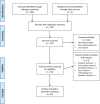Is loss of sense of smell a diagnostic marker in COVID-19: A systematic review and meta-analysis
- PMID: 32741085
- PMCID: PMC7436734
- DOI: 10.1111/coa.13620
Is loss of sense of smell a diagnostic marker in COVID-19: A systematic review and meta-analysis
Abstract
Aims: To systematically review the currently available evidence investigating the association between olfactory dysfunction (OD) and the novel coronavirus (COVID-19). To analyse the prevalence of OD in patients who have tested positive on polymerase chain reaction (PCR) for COVID-19. To perform a meta-analysis of patients presenting with olfactory dysfunction, during the pandemic, and to investigate the positive predictive value for a COVID-19-positive result in this population. To assess whether olfactory dysfunction could be used as a diagnostic marker for COVID-19 positivity and aid public health approaches in tackling the current outbreak.
Methods: We systematically searched MedLine (PubMed), Embase, Health Management Information Consortium (HMIC), Medrxiv, the Cochrane Library, the Cochrane COVID-19 Study Register, NIHR Dissemination centre, Clinical Evidence, National Health Service Evidence and the National Institute of Clinical Excellence to identify the current published evidence which associates coronaviridae or similar RNA viruses with anosmia. The initial search identified 157 articles. A total of 145 papers were excluded following application of our exclusion criteria. The 12 remaining articles that presented evidence on the association between COVID-19 and olfactory dysfunction were critically analysed.
Results: Olfactory dysfunction has been shown to be the strongest predictor of COVID-19 positivity when compared to other symptoms in logistic regression analysis. In patients who had tested positive for COVID-19, there was a prevalence of 62% of OD. In populations of patients who are currently reporting OD, there is a positive predictive value of 61% for a positive COVID-19 result.
Conclusion: Our review has shown that there is already significant evidence which demonstrates an association between OD and the novel coronavirus-COVID-19. It is unclear if this finding is unique to this coronavirus as individual viral phenotypes rarely present in such concentrated large numbers. We have demonstrated that OD is comparatively more predictive for COVID-19 positivity compared to other associated symptoms. We recommend that people who develop OD during the pandemic should be self-isolate and this guidance should be adopted internationally to prevent transmission.
Keywords: 2019 novel coronavirus disease; Anosmia; COVID-19; SARS coronavirus; SARS virus; olfaction disorders; smell.
© 2020 John Wiley & Sons Ltd.
Conflict of interest statement
The authors declare that they have no relevant or material financial interests that relate to the research described in this paper.
Figures
References
-
- Hopkins C, Kumar N.Loss of sense of smell as a marker of COVID‐19 infection. https://www.entuk.org/. Accessed July 3, 2020.
-
- Barr S.Why are loss of smell and taste reportedly symptoms of COVID‐19? The Independent. https://www.independent.co.uk/life‐style/. Accessed July 3, 2020.
Publication types
MeSH terms
LinkOut - more resources
Full Text Sources
Medical
Miscellaneous


